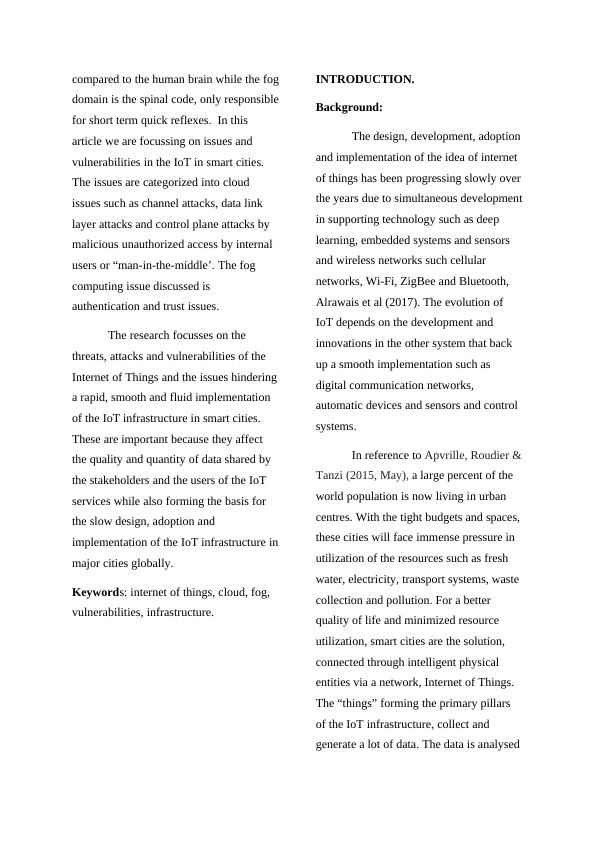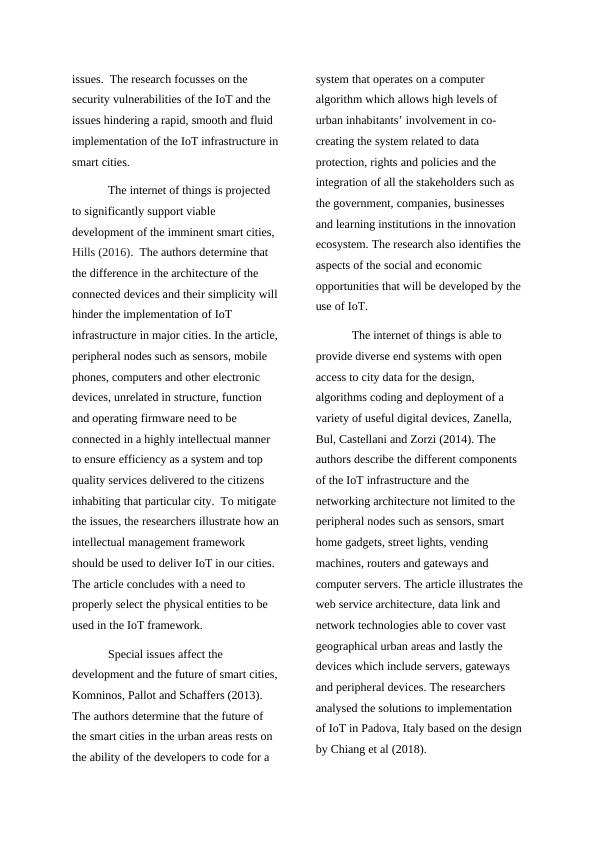(pdf) Internet of things - IOT
Added on 2021-06-17
17 Pages6434 Words71 Views
INTERNET OF THINGSSMART CITYBy(Name) (Course)(Professor’s Name)(Institution)(State)(Date)AbstractThe internet of things, formed by interconnected physical devices “things”. The physical entities are connected using wireless networks to integrate their functionality to improve functional servicedelivery to the city inhabitants. The physical entities that form the primary aspect of the IoT infrastructure include things such as sensors, meters, street lightsand train ticket vending machines. The internet of things is therefore formed by physical entities, the “things”, a network connection framework such as cellular network, wireless local area networks and wide area networks and central servers thatoffer data management services such as analysis, storage and control. The central servers are categorized into cloud and fog computing domains according to the location within the Internet of Things infrastructure. Cloud computing provides central data resource management functionalities while fog computing operates on the edges of the network connecting the Internet of Things providing data management to small quantities of short term data. Fog domain compliments the cloud platform in performing short-term data analysis without having the electronic devices sent the data to the cloud that involves long distances and time. The cloud can be

compared to the human brain while the fogdomain is the spinal code, only responsiblefor short term quick reflexes. In this article we are focussing on issues and vulnerabilities in the IoT in smart cities. The issues are categorized into cloud issues such as channel attacks, data link layer attacks and control plane attacks by malicious unauthorized access by internal users or “man-in-the-middle’. The fog computing issue discussed is authentication and trust issues. The research focusses on the threats, attacks and vulnerabilities of the Internet of Things and the issues hinderinga rapid, smooth and fluid implementation of the IoT infrastructure in smart cities. These are important because they affect the quality and quantity of data shared by the stakeholders and the users of the IoT services while also forming the basis for the slow design, adoption and implementation of the IoT infrastructure inmajor cities globally. Keywords: internet of things, cloud, fog, vulnerabilities, infrastructure. INTRODUCTION. Background: The design, development, adoptionand implementation of the idea of internet of things has been progressing slowly overthe years due to simultaneous developmentin supporting technology such as deep learning, embedded systems and sensors and wireless networks such cellular networks, Wi-Fi, ZigBee and Bluetooth, Alrawais et al (2017). The evolution of IoT depends on the development and innovations in the other system that back up a smooth implementation such as digital communication networks, automatic devices and sensors and control systems. In reference to Apvrille, Roudier &Tanzi (2015, May), a large percent of the world population is now living in urban centres. With the tight budgets and spaces, these cities will face immense pressure in utilization of the resources such as fresh water, electricity, transport systems, waste collection and pollution. For a better quality of life and minimized resource utilization, smart cities are the solution, connected through intelligent physical entities via a network, Internet of Things. The “things” forming the primary pillars of the IoT infrastructure, collect and generate a lot of data. The data is analysed

and managed within the servers located within the cloud or the fog domains. The physical entities such as sensors do not have the capacity to compute nor store data hence transmit the data to the cloud. The use of wireless networks to transmit data exposes the whole system to threats and attacks that compromise the data privacy. Establishment of the IoT infrastructure faced many challenges in thedesign and implementation of the new technology. Literature review. Chang, V. (2016) illustrates that the time for the adoption of the internet to connect physical entities such as sensors toprovide services to the people in large cities is here. This new invention according to the author, is favoured by the wide acceptance and connection to the internet by the users using computers and mobile phones. The author notes the following as the key challenges to the implementation of IoT in the European cities including research and innovation into discovery of new products that can be connected to the IoT, design a new privacyguide for the IoT framework, security mechanisms to protect the infrastructure, formation of an ethics and code of conductbetween developers and the consumers andlastly implement cloud computing for IoT. The author concludes that the world cannot run away from the future but rather face the challenges and make the impossible possible.According to Edwards (2014). The central servers are categorized into cloud and fog computing domains according to the location within the Internet of Things infrastructure. Cloud computing provides central data resource management functionalities while fog computing operates on the edges of the network connecting the IoT providing data management to small quantities of short term data. Fog domain compliments the cloud platform in performing short-term data analysis without having the electronicdevices sent the data to the cloud that involves long distances and time. The cloud can be compared to the human brain while the fog domain is the spinal code, only responsible for short term quick reflexes. In this article we are focussing on issues and vulnerabilities in the IoT in smart cities, Crasta et al (2018). The issuesare categorized into cloud issues such as channel attacks, data link layer attacks andcontrol plane attacks by malicious unauthorized access by internal users or “man-in-the-middle’. The fog computing issue discussed is authentication and trust

issues. The research focusses on the security vulnerabilities of the IoT and the issues hindering a rapid, smooth and fluid implementation of the IoT infrastructure insmart cities. The internet of things is projected to significantly support viable development of the imminent smart cities, Hills (2016). The authors determine that the difference in the architecture of the connected devices and their simplicity willhinder the implementation of IoT infrastructure in major cities. In the article,peripheral nodes such as sensors, mobile phones, computers and other electronic devices, unrelated in structure, function and operating firmware need to be connected in a highly intellectual manner to ensure efficiency as a system and top quality services delivered to the citizens inhabiting that particular city. To mitigate the issues, the researchers illustrate how anintellectual management framework should be used to deliver IoT in our cities. The article concludes with a need to properly select the physical entities to be used in the IoT framework. Special issues affect the development and the future of smart cities,Komninos, Pallot and Schaffers (2013). The authors determine that the future of the smart cities in the urban areas rests on the ability of the developers to code for a system that operates on a computer algorithm which allows high levels of urban inhabitants’ involvement in co-creating the system related to data protection, rights and policies and the integration of all the stakeholders such as the government, companies, businesses and learning institutions in the innovation ecosystem. The research also identifies theaspects of the social and economic opportunities that will be developed by theuse of IoT. The internet of things is able to provide diverse end systems with open access to city data for the design, algorithms coding and deployment of a variety of useful digital devices, Zanella, Bul, Castellani and Zorzi (2014). The authors describe the different components of the IoT infrastructure and the networking architecture not limited to the peripheral nodes such as sensors, smart home gadgets, street lights, vending machines, routers and gateways and computer servers. The article illustrates theweb service architecture, data link and network technologies able to cover vast geographical urban areas and lastly the devices which include servers, gateways and peripheral devices. The researchers analysed the solutions to implementation of IoT in Padova, Italy based on the designby Chiang et al (2018).

End of preview
Want to access all the pages? Upload your documents or become a member.
Related Documents
Internet of things - Assignmentlg...
|13
|4549
|42
Internet of Things: Privacy Issues and Contentslg...
|9
|1402
|116
Security and Privacy Issues in Cloud and Fog Domainlg...
|5
|823
|66
Future of the Fog Domain: Solutions for Limitations and Better Technologylg...
|10
|9284
|160
Mobile technologies and Internet of Thingslg...
|5
|1015
|72
The Future of Fog Domainlg...
|17
|3771
|85
